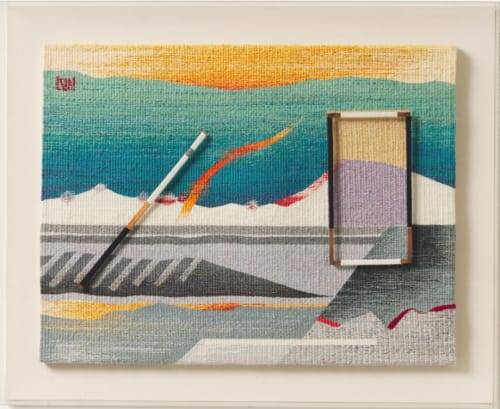On August 22 in New York, the groundbreaking Korean fiber artistLee ShinJa will unveil her first solo presentation with Tina Kim Gallery, “Weaving the Dawn,” on view through September 28.
An iconic figure in Korean art history for first sparking the immersive “tapestry” style, Lee brings new, vibrant perspectives to the now beloved art form. The sweeping exhibition voyages through over 50 years of her tender artistry, including cutting-edge 1960s embroidered appliqué creations and the freshly developed “Spirit of the Mountain” series. Visitors will have a singular opportunity to get a closer look at initial sketches, archival treasures, as well as documents illuminating her drive as a prestigious researcher and educator.
The Poetry of Textiles, Handed Down by Generations of Women
Lee ShinJa was born and raised in Uljin, Korea, during the challenging time of Japanese colonial rule. She was introduced to the poetry of textiles by way of her mother and grandmother, entranced by their sewing and weaving skills.
The instinctive Lee fused dyeing and appliqué into her dynamic practice from the beginning, and pioneering works such as Image of the City (1961), Portrait of My Daughter (1962), and Screen (1979) reveal evolving skills with sculptural complexity. Lee burst through textile conventions with the addition of abstract, human imagery and bold techniques, deftly melding craft and fine art into unparalleled masterpieces.
The 1970s brought about Lee’s revelations in tapestry, and the ideation of avant-garde dyeing techniques and exploration with unusual materials like secondhand wool and bedding culminated in bountiful works of art.
Sun and Moon I (1973) dazzles with geometric patterns and melodic colorways. Delving into mesmeric installations in the 1980s connected Lee with fellow luminaries Issey Miyake and Magdalena Abakanowicz during textile shows at the National Museum of Modern and Contemporary Art, Korea.
Lee ShinJa Taps into the Healing Power of Nature, Memory, and Creativity
After experiencing the profound loss of her husband, painter Chang Woon Sang, and becoming a single parent, Lee found revitalizing strength in her artistry.
Solo exhibitions placed the renewing power of nature at their heart, and works including Legend, The World is Beautiful, and Dawn, created between 1984 and 1993, evoked the spiritual energy of our precious environment. Warm imagery of the ocean, sky, and sunlight imparted to audiences everlasting optimism and the safeguarding of memory.
“Growing up in a rural area, I vividly remember the intense sunlight at sunrise and sunset,” said Lee about her childhood. “I have cherished memories of climbing mountains with my father every morning to witness these moments. The sunlight rising from the East Sea left a lasting impression on me. I have always believed in creating nature as I see it. However, I still feel that my work has yet to match the beauty of my hometown.”
“Spirit of the Mountain” Leads to “Weaving the Dawn”
The ever-inspired artist concentrated on developing abstract works in the 1990s, and the “Spirit of the Mountain” ushered in a new era for Lee, utilizing diverse materials to unearth the vigor of heavenly mountain ranges. Since then, sculptural abstraction has been a radiant focus for the creative, intermeshing details of metal and wood into lush tapestries.
In “Weaving the Dawn,” rich shades of yellow, black, red, and gray endure, and jubilant experimentation with surreal shadow and architectural drama flourishes. Invigorated by traditional Korean houses, hanok, Lee’s artworks are akin to peering into prismatic windows where Mother Nature is queen and the soul discovers its reverie.
—Erica Silverman


